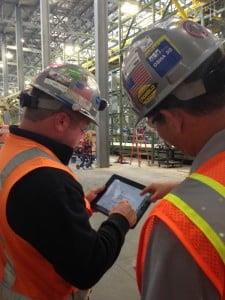 ElectricalConnection.org
ElectricalConnection.org
Connect with Us:
Facebook
LinkedIn
Twitter
YouTube
As seen in the St. Louis Business Journal...
On any given day, you might find an IBEW Local 1 foreman walking a job site holding a tablet and not the traditional blueprints under his arm. Nearby, an IBEW electrician may have a tablet on his tool cart to review precision design and engineering plans for duct work installations that must accommodate low voltage/power needs, mechanical piping, and plumbing. Welcome to building information modeling (BIM) which is now being embraced at all levels on projects — from designers and engineers to journey workers. 
Eight years ago, the St. Louis Business Journal first documented the growing use of BIM and the added dimensions it brought to 3D modeling in the construction industry. At the time, architects and engineers were the predominant users. Soon, general contractors and more recently, subcontractors, adopted BIM to deliver greater coordination on projects. Now, IBEW journey workers are being trained in BIM. BIM is all about delivering greater spatial coordination to construction projects. It also enhances continuity and clarity by integrating scheduling, budget and constructability into the design and planning process. So it’s not surprising that the St. Louis Electrical Industry Training Center is introducing BIM to IBEW field installers. The curriculum includes:
Continuity on projects is coalescing around BIM to fully capitalize on the special talents of building team members. Three years ago, the National Electrical Contractors Association (NECA) collaborated with the Mechanical Contractors Association of America (MCAA) and the Sheet Metal and Air Conditioning Contractors National Association (SMACNA) to produce “Achieving Spatial Coordination through BIM–A Guide for Specialty Contractors.” Spatial coordination using BIM resolves issues and avoids costly redesign before installations begin. It mitigates change orders and avoids misinformation that contribute to unbudgeted costs.
IBEW was pulled into the BIM process to leverage field installation experience that could reveal unforeseen conflicts in design. This is especially important in working with different trades whose plans are integrated in BIM. Imagine having to route a spaghetti-like sea of more than 300 conduits around yet-to-be-placed structural piers for a data center while also accommodating the facility’s intense mechanical installations for cooling. It is inefficient to design in silos for specific trades — everything should be integrated.
The precision of BIM also facilitates prefabrication off site. Assembling project components in a controlled environment can produce a higher quality and improve productivity in the field. It can also make projects safer as preassembling items on the ground reduces the time workers spend at high elevations exposed to fall hazards.
20 years ago, the Electrical Connection IBEW/NECA partnership initiated a new technology curriculum at its training center in anticipation of smart building needs, voice/data/video, the growth of data centers and ultimately today’s digital age. The foresight in keeping pace with technology infrastructure needs has now come full circle by helping innovate with BIM to deliver greater precision and efficiencies in construction.
Recent News